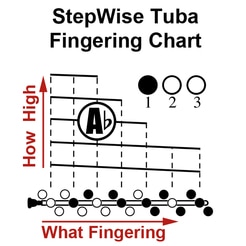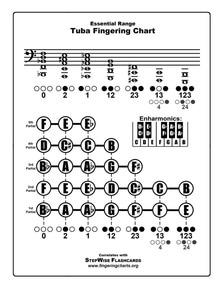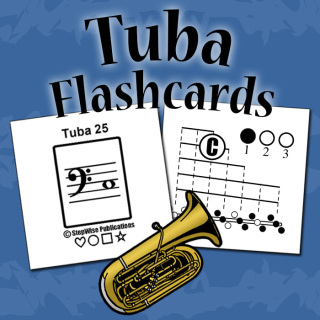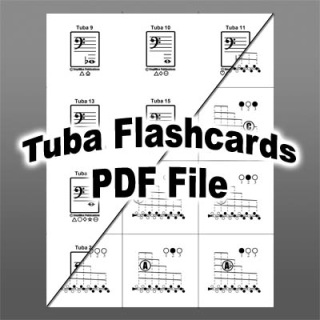How to Play the Tuba - Fingering Chart & Flashcards
Download the StepWise Tuba Fingering Chart
|
Most fingering charts found in the back of Tuba method books do not organize the notes into the overtone series or show them lined up over the correct valve combinations. This free chart shows young musicians how the notes on the tuba are organized by fingering and partial, making them easier to memorize. It also shows the alternate 4-valve fingering options.
As a bonus, everything fits easily on one page, allowing young tuba players to keep this chart on their music stand and use it as a quick reference. I like to print these StepWise fingering charts for every beginning band member on cardstock, and pass them out in the first week of school, along with the fingering flashcards. It is a powerful combination! Download now by right-clicking this link:
| |||
Tuba Fingering Flashcards
|
Somehow, most beginning Tuba players are able to make sense of the notes way down on all those ledger lines. But once they are supposed to start playing notes higher up on the staff...look out! ANY note is possible, but the wrong note can be expected. Then there are all those pesky accidentals, and even very intelligent tuba players get confused.
These flashcards will help both beginning and more advanced players learn and memorize every note (and fingering) on the tuba. They will even become excellent sight readers! An explanation of the StepWise system for representing pitch, fingerings, tube lengths, and partials is provided in this video and in the description below. |
|
Understanding Tuba Fingerings: Valves, Fingerings, and Partials

The Tuba valves are shown across the bottom of this chart. The valve combinations are organized from shortest tubing (open) to longest tubing (1-2-3), similar to trombone positions. This helps tuba players memorize the fingerings for chromatic motion.
You may notice that the distance between each valve combination is slightly greater than the one before it. This helps explain why the 3rd valve tubing must be extended to play the 1-3 and 1-2-3 combinations in tune.
Meanwhile, in order to play the A-flat in the graphic, you must press the 1st valve and then buzz the mouthpiece up to the 3rd Partial, as shown. Most fingering charts do not show how high or low a note is, only the fingering. This is what makes the StepWise system for learning to play brass instruments superior to all others that we have encountered.
You may notice that the distance between each valve combination is slightly greater than the one before it. This helps explain why the 3rd valve tubing must be extended to play the 1-3 and 1-2-3 combinations in tune.
Meanwhile, in order to play the A-flat in the graphic, you must press the 1st valve and then buzz the mouthpiece up to the 3rd Partial, as shown. Most fingering charts do not show how high or low a note is, only the fingering. This is what makes the StepWise system for learning to play brass instruments superior to all others that we have encountered.
Awesome Tuba Bass Lines
|
Wanna have some fun with the tuba? Download these 11 AWESOME tuba bass lines (below) and get busy! This YouTube video shows you how it should sound, and can also be used for tuba recruiting purposes. After all, it IS INDEED "All About That Bass", and because the tuba is the foundation instrument of the band's sound pyramid, it is BOSS!
The songs in this PDF & video are: Play That Funky Music, Beat It, 99 Red Balloons, Don't Stop Believing', Chameleon, I Want You Back, Uptown Funk, Another One Bites the Dust, The Pink Panther, Bad, and Seven Nation Army.
|
| ||||||




